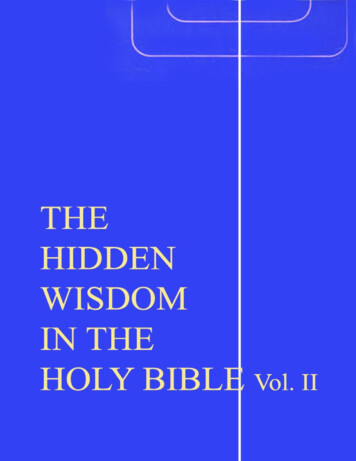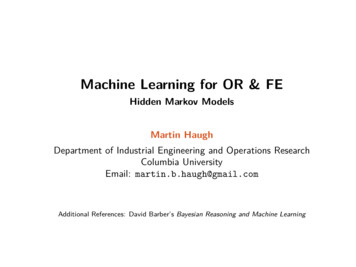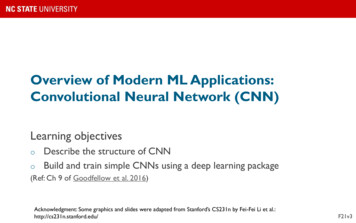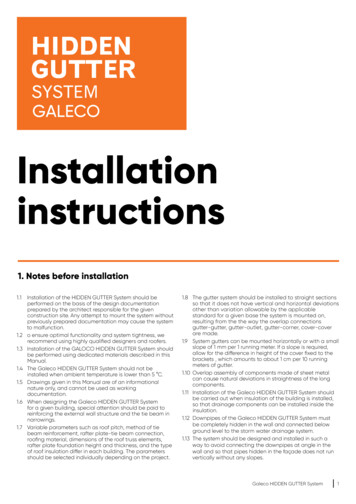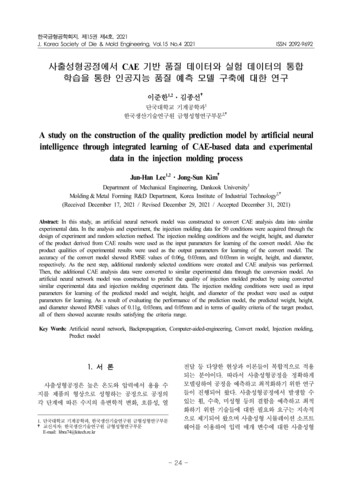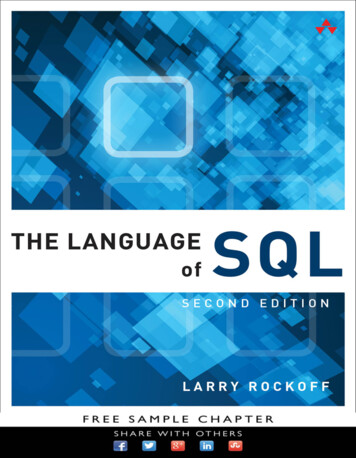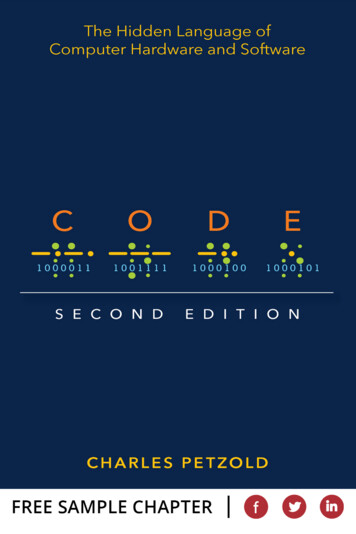
Transcription
The Hidden Language ofComputer Hardware and SoftwareCO10000111001111S E C O N DD1000100E1000101E D I T I O NCHARLES PETZOLD
Code: The Hidden Language of Computer Hardware and Software: Second EditionPublished with the authorization of Microsoft Corporation by: Pearson Education, Inc.Copyright 2023 by Charles Petzold.All rights reserved. This publication is protected by copyright, and permission must beobtained from the publisher prior to any prohibited reproduction, storage in a retrievalsystem, or transmission in any form or by any means, electronic, mechanical, photocopying, recording, or likewise. For information regarding permissions, request forms, and theappropriate contacts within the Pearson Education Global Rights & Permissions Department, please visit www.pearson.com/permissions.No patent liability is assumed with respect to the use of the information contained herein.Although every precaution has been taken in the preparation of this book, the publisherand author assume no responsibility for errors or omissions. Nor is any liability assumedfor damages resulting from the use of the information contained herein.ISBN-13: 978-0-13-790910-0ISBN-10: 0-13-790910-1Library of Congress Control Number: ft and the trademarks listed at http://www.microsoft.com on the “Trademarks”webpage are trademarks of the Microsoft group of companies. All other marks are property of their respective owners.Warning and DisclaimerEvery effort has been made to make this book as complete and as accurate as possible, butno warranty or fitness is implied. The information provided is on an “as is” basis. Theauthor, the publisher, and Microsoft Corporation shall have neither liability nor responsibility to any person or entity with respect to any loss or damages arising from the information contained in this book or from the use of the programs accompanying it.Special SalesFor information about buying this title in bulk quantities, or for special sales opportunities(which may include electronic versions; custom cover designs; and content particular toyour business, training goals, marketing focus, or branding interests), please contact ourcorporate sales department at corpsales@pearsoned.com or (800) 382-3419.For government sales inquiries, please contact governmentsales@pearsoned.com.For questions about sales outside the U.S., please contact intlcs@pearson.com.
ContentsAbout the AuthorPreface to the Second EditionvviiChapter OneBest Friends1Chapter TwoCodes and Combinations7Chapter ThreeBraille and Binary Codes13Chapter FourAnatomy of a Flashlight21Chapter FiveCommunicating Around Corners31Chapter SixLogic with Switches41Chapter SevenTelegraphs and Relays57Chapter EightRelays and Gates65Chapter NineOur Ten Digits91Chapter TenAlternative 10s99Chapter ElevenBit by Bit by Bit117Chapter TwelveBytes and Hexadecimal139Chapter ThirteenFrom ASCII to Unicode149Chapter FourteenAdding with Logic Gates169Chapter FifteenIs This for Real?183Chapter SixteenBut What About Subtraction?197Chapter SeventeenFeedback and Flip-Flops213Chapter EighteenLet’s Build a Clock!241Chapter NineteenAn Assemblage of Memory267Chapter TwentyAutomating Arithmetic289Chapter Twenty-OneThe Arithmetic Logic Unit315Chapter Twenty-TwoRegisters and Busses335Chapter Twenty-ThreeCPU Control Signals355iii
CodeivChapter Twenty-FourLoops, Jumps, and Calls379Chapter Twenty-FivePeripherals403Chapter Twenty-SixThe Operating System413Chapter Twenty-SevenCoding425Chapter Twenty-EightThe World Brain447Index461
Aboutthe AuthorCharles Petzold is also the author of The Annotated Turing: A Guided Tour through Alan Turing’sHistoric Paper on Computability and the TuringMachine (Wiley, 2008). He wrote a bunch of otherbooks too, but they’re mostly about programmingapplications for Microsoft Windows, and they’reall obsolete now. He lives in New York City withhis wife, historian and novelist Deirdre Sinnott, andtwo cats named Honey and Heidi. His website is www.charlespetzold.com.v
This page intentionally left blank
Preface to theSecond EditionThe first edition of this book was published in September 1999. Withmuch delight I realized that I had finally written a book that wouldnever need revising! This was in stark contrast to my first book,which was about programming applications for Microsoft Windows. Thatone had already gone through five editions in just ten years. My secondbook on the OS/2 Presentation Manager (the what?) became obsolete muchmore quickly. But Code, I was certain, would last forever.My original idea with Code was to start with very simple concepts butslowly build to a very deep understanding of the workings of digital computers. Through this steady progression up the hill of knowledge, I wouldemploy a minimum of metaphors, analogies, and silly illustrations, andinstead use the language and symbols of the actual engineers who designand build computers. I also had a very clever trick up my sleeve: I would useancient technologies to demonstrate universal principles under the assumption that these ancient technologies were already quite old and would neverget older. It was as if I were writing a book about the internal combustionengine but based on the Ford Model T.I still think that my approach was sound, but I was wrong in some ofthe details. As the years went by, the book started to show its age. Some ofthe cultural references became stale. Phones and fingers supplemented keyboards and mice. The internet certainly existed in 1999, but it was nothinglike what it eventually became. Unicode—the text encoding that allows auniform representation of all the world’s languages as well as emojis—gotless than a page in the first edition. And JavaScript, the programming language that has become pervasive on the web, wasn’t mentioned at all.Those problems would probably have been easy to fix, but there existedanother aspect of the first edition that continued to bother me. I wantedto show the workings of an actual CPU—the central processing unit thatvii
Codeviiiforms the brain, heart, and soul of a computer—but the first edition didn’tquite make it. I felt that I had gotten close to this crucial breakthrough butthen I had given up. Readers didn’t seem to complain, but to me it was aglaring flaw.That deficiency has been corrected in this second edition. That’s why it’ssome 70 pages longer. Yes, it’s a longer journey, but if you come along withme through the pages of this second edition, we shall dive much deeper intothe internals of the CPU. Whether this will be a more pleasurable experience for you or not, I do not know. If you feel like you’re going to drown,please come up for air. But if you make it through Chapter 24, you shouldfeel quite proud, and you’ll be pleased to know that the remainder of thebook is a breeze.The Companion WebsiteThe first edition of Code used the color red in circuit diagramsto indicate the flow of electricity. The second edition does thatas well, but the workings of these circuits are now also illustrated in a more graphically interactive way on a new websitecalled CodeHiddenLanguage.com.You’ll be reminded of this website occasionally throughout the pages ofthis book, but we’re also using a special icon, which you’ll see in the marginof this paragraph. Hereafter, whenever you see that icon—usually accompanying a circuit diagram—you can explore the workings of the circuit onthe website. (For those who crave the technical background, I programmedthese web graphics in JavaScript using the HTML5 canvas element.)The CodeHiddenLanguage.com website is entirely free to use. There isno paywall, and the only advertisement you’ll see is for the book itself. Ina few of the examples, the website uses cookies, but only to allow you tostore some information on your computer. The website doesn’t track youor do anything evil.I will also be using the website for clarifications or corrections of material in the book.The People ResponsibleThe name of one of the people responsible for this book is on the cover;some others are no less indispensable but appear inside on the copyrightand colophon pages.In particular, I want to call out Executive Editor Haze Humbert, whoapproached me about the possibility of a second edition uncannily at precisely the right moment that I was ready to do it. I commenced work inJanuary 2021, and she skillfully guided us through the ordeal, even as thebook went several months past its deadline and when I needed some reassurance that I hadn’t completely jumped the shark.
CodeixThe project editor for the first edition was Kathleen Atkins, who alsounderstood what I was trying to do and provided many pleasant hours ofcollaboration. My agent at that time was Claudette Moore, who also sawthe value of such a book and convinced Microsoft Press to publish it.The technical editor for the first edition was Jim Fuchs, who I remember catching a lot of embarrassing errors. For the second edition, technicalreviewers Mark Seemann and Larry O’Brien also caught a few flubs andhelped me make these pages better than they would have been otherwise.I thought that I had figured out the difference between “compose” and“comprise” decades ago, but apparently I have not. Correcting errors likethat was the invaluable contribution of copy editor Scout Festa. I havealways relied on the kindness of copyeditors, who too often remain anonymous strangers but who battle indefatigably against imprecision and abuseof language.Any errors that remain in this book are solely my responsibility.I want to again thank my beta readers of the first edition: Sheryl Canter,Jan Eastlund, the late Peter Goldeman, Lynn Magalska, and DeirdreSinnott (who later became my wife).The numerous illustrations in the first edition were the work of the lateJoel Panchot, who I understand was deservedly proud of his work on thisbook. Many of his illustrations remain, but the need for additional circuitdiagrams inclined me to redo all the circuits for the sake of consistency.(More technical background: These illustrations were generated by a program I wrote in C# using the SkiaSharp graphics library to generate Scalable Vector Graphics files. Under the direction of Senior Content ProducerTracey Croom, the SVG files were converted into Encapsulated PostScriptfor setting up the pages using Adobe InDesign.)And FinallyI want to dedicate this book to the two most important women in my life.My mother battled adversities that would have destroyed a lesser person.She provided a strong direction to my life without ever holding me back.We celebrated her 95th (and final) birthday during the writing of this book.My wife, Deirdre Sinnott, has been essential and continues to make meproud of her achievements, her support, and her love.And to the readers of the first edition, whose kind feedback has beenextraordinarily gratifying.Charles PetzoldMay 9, 2022
CodexPearson’s Commitment toDiversity, Equity, and InclusionPearson is dedicated to creating bias-free content that reflects the diversityof all learners. We embrace the many dimensions of diversity, including butnot limited to race, ethnicity, gender, socioeconomic status, ability, age,sexual orientation, and religious or political beliefs.Education is a powerful force for equity and change in our world. Ithas the potential to deliver opportunities that improve lives and enableeconomic mobility. As we work with authors to create content for everyproduct and service, we acknowledge our responsibility to demonstrateinclusivity and incorporate diverse scholarship so that everyone can achievetheir potential through learning. As the world’s leading learning company,we have a duty to help drive change and live up to our purpose to help morepeople create a better life for themselves and to create a better world.Our ambition is to purposefully contribute to a world where: Everyone has an equitable and lifelong opportunity to succeedthrough learning. Our educational products and services are inclusive and representthe rich diversity of learners. Our educational content accurately reflects the histories andexperiences of the learners we serve. Our educational content prompts deeper discussions withlearners and motivates them to expand their own learning(and worldview).While we work hard to present unbiased content, we want to hear fromyou about any concerns or needs with this Pearson product so that we caninvestigate and address them. Please contact us with concerns about any potential bias athttps://www.pearson.com/report-bias.html.
Chapter SixLogic with SwitchesWhat is truth? Aristotle thought that logic had something to dowith it. The collection of his teachings known as the Organon(which dates from the fourth century BCE) is the earliest extensive writing on the subject of logic. To the ancient Greeks, logic was ameans of analyzing language in the search for truth and thus was considered a form of philosophy. The basis of Aristotle’s logic was the syllogism.The most famous syllogism (which isn’t actually found in the works ofAristotle) isAll men are mortal;Socrates is a man;Hence, Socrates is mortal.In a syllogism, two premises are assumed to be correct, and from these aconclusion is deduced.The mortality of Socrates might seem straightforward enough, but thereare many varieties of syllogisms. For example, consider the following twopremises, proposed by the 19th-century mathematician Charles Dodgson(also known as Lewis Carroll):All philosophers are logical;An illogical man is always obstinate.The conclusion—Some obstinate persons are not philosophers—isn’tobvious at all. Notice the unexpected and disturbing appearance of theword some.For over two thousand years, mathematicians wrestled with Aristotle’slogic, attempting to corral it using mathematical symbols and operators.41
Prior to the 19th century, the only person to come close was GottfriedWilhelm von Leibniz (1648–1716), who dabbled with logic early in life butthen went on to other interests (such as independently inventing calculus atthe same time as Isaac Newton).And then came George Boole.George Boole was born in England in 1815 intoa world where the odds were certainly stackedagainst him. Because he was the son of a shoemaker and a former maid, Britain’s rigid classstructure would normally have prevented Boolefrom achieving anything much different from hisancestors. But aided by an inquisitive mind andhis helpful father (who had strong interests in science, mathematics, and literature), young Georgegave himself the type of education that was normally the privilege of upper-class boys; his studies included Latin, Greek, and mathematics. As aresult of his early papers on mathematics, in 1849Boole was appointed the first Professor of Mathematics at Queen’s College,Cork, in Ireland.Several mathematicians in the mid-1800s had been working on a mathematical definition of logic (most notably Augustus De Morgan), but it wasBoole who had the real conceptual breakthrough, first in the short bookThe Mathematical Analysis of Logic, Being an Essay Towards a Calculusof Deductive Reasoning (1847) and then in a much longer and more ambitious text, An Investigation of the Laws of Thought on Which Are Foundedthe Mathematical Theories of Logic and Probabilities (1854), more conveniently referred to as The Laws of Thought. Boole died in 1864, at the ageof 49, after hurrying to class in the rain and contracting pneumonia.The title of Boole’s 1854 book suggests an ambitious motivation: Boolebelieved that the human brain uses logic to think, so if we were to find away to represent logic with mathematics, we would also have a mathematical description of how the brain works. But Boole’s mathematics can bestudied without necessarily buying in to his neuropsychology.Boole invented a whole different kind of algebra that was eventuallycalled Boolean algebra to distinguish it from conventional algebra.In conventional algebra, letters are often used to stand for numbers.These are called operands, and they are combined in various ways withoperators, most often and . For example:A 3 (B 5)When we do conventional algebra, we follow certain rules. These ruleshave probably become so ingrained in our practice that we no longer thinkof them as rules and might even forget their names. But rules indeed underlie all the workings of any form of mathematics.Science & Society Picture Library/Getty ImagesChapter Six42
Logic with Switches43The first rule is that addition and multiplication are commutative. Thatmeans we can switch around the symbols on each side of the operators:A B B AA B B ABy contrast, subtraction and division are not commutative.Addition and multiplication are also associative, that isA (B C) (A B) CA (B C) (A B) CAnd finally, multiplication is said to be distributive over addition:A (B C) (A B) (A C)Another characteristic of conventional algebra is that it always dealswith numbers, such as pounds of tofu or numbers of ducks or distances thata train travels or the seconds of a day.It was Boole’s genius to make algebra more abstract by divorcing it fromconcepts of number. In Boolean algebra, the operands refer not to numbersbut instead to classes. A class is simply a group of things, similar to what inlater times came to be known as a set.Let’s talk about cats. Cats can be either male or female. For convenience,we can use the letter M to refer to the class of male cats and F to refer tothe class of female cats. Keep in mind that these two symbols do not represent numbers of cats. The number of male and female cats can change bythe minute as new cats are born and old cats (regrettably) pass away. Theletters stand for classes of cats—cats with specific characteristics. Insteadof referring to male cats, we can just say “M.”We can also use other letters to represent the color of the cats. For example, T can refer to the class of tan cats, B can be the class of black cats, Wthe class of white cats, and O the class of cats of all “other” colors—all catsnot in the class T, B, or W.Finally (at least as far as this example goes), cats can be either neuteredor unneutered. Let’s use the letter N to refer to the class of neutered catsand U for the class of unneutered cats.In conventional (numeric) algebra, the operators and are used toindicate addition and multiplication. In Boolean algebra, the same and symbols are used, and here’s where things might get confusing. Everybodyknows how to add and multiply numbers in conventional algebra, but howdo we add and multiply classes?Well, we don’t actually add and multiply in Boolean algebra. Instead, the and symbols mean something else entirely.The symbol in Boolean algebra means a union of two classes. A unionof two classes is everything in the first class combined with everything inthe second class. For example, B W represents the class of all cats that areeither black or white.
Chapter Six44The symbol in Boolean algebra means an intersection of two classes.An intersection of two classes is everything that is in both the first classand the second class. For example, F T represents the class of all cats thatare both female and tan. As in conventional algebra, we can write F T asF·T or simply FT (which is what Boole preferred). You can think of the twoletters as two adjectives strung together: “female tan” cats.To avoid confusion between conventional algebra and Boolean algebra,sometimes the symbols and are used for union and intersection insteadof and . But part of Boole’s liberating influence on mathematics was tomake the use of familiar operators more abstract, so I’ve decided to stickwith his decision not to introduce new symbols into his algebra.The commutative, associative, and distributive rules all hold for Booleanalgebra. What’s more, in Boolean algebra the operator is distributive overthe operator. This isn’t true of conventional algebra:W (B F) (W B) (W F)The union of white cats and black female cats is the same as the intersection of two unions: the union of white cats and black cats, and the union ofwhite cats and female cats. This is somewhat difficult to grasp, but it works.Three more symbols are necessary to complete Boolean algebra. Twoof these symbols might look like numbers, but they’re really not becausethey’re treated a little differently than numbers. The symbol 1 in Booleanalgebra means “the universe”—that is, everything we’re talking about. Inthis example, the symbol 1 means “the class of all cats.” Thus,M F 1This means that the union of male cats and female cats is the class of allcats. Similarly, the union of tan cats and black cats and white cats and othercolored cats is also the class of all cats:T B W O 1And you achieve the class of all cats this way, too:N U 1The 1 symbol can be used with a minus sign to indicate the universeexcluding something. For example,1–Mis the class of all cats except the male cats. The universe excluding all malecats is the same as the class of female cats:1–M F
Logic with Switches45The third symbol that we need is the 0 (zero), and in Boolean algebra the0 means an empty class—a class of nothing. The empty class results whenwe take an intersection of two mutually exclusive classes—for example,cats that are both male and female:F M 0Notice that the 1 and 0 symbols sometimes work the same way in Boolean algebra as in conventional algebra. For example, the intersection of allcats and female cats is the class of female cats:1 F FThe intersection of no cats and female cats is the class of no cats:0 F 0The union of no cats and all female cats is the class of female cats:0 F FBut sometimes the result doesn’t look the same as in conventionalalgebra. For example, the union of all cats and female cats is the class ofall cats:1 F 1This doesn’t make much sense in conventional algebra.Because F is the class of all female cats, and (1 F) is the class of all catsthat aren’t female, the union of these two classes is 1:F (1 F) 1And the intersection of the two classes is 0:F (1 F) 0Historically, this formulation represents an important concept in logic:It’s called the law of contradiction, and it indicates that something can’t beboth itself and the opposite of itself.Where Boolean algebra really looks different from conventional algebrais in a statement like this:F F FThe statement makes perfect sense in Boolean algebra: The intersectionof female cats and female cats is still the class of female cats. But it surewouldn’t look quite right if F referred to a number. Boole consideredX2 X
Chapter Six46to be the single statement that differentiates his algebra from conventionalalgebra. Another Boolean statement that looks funny in terms of conventional algebra is this:F F FThe union of female cats and female cats is still the class of female cats.Boolean algebra provides a mathematical method for solving the syllogisms of Aristotle. Let’s look at the first two-thirds of that famous syllogismagain, but now using gender-neutral language:All persons are mortal;Socrates is a person.We’ll use P to represent the class of all persons, M to represent the classof mortal things, and S to represent the class of Socrates. What does itmean to say that “all persons are mortal”? It means that the intersectionof the class of all persons and the class of all mortal things is the class ofall persons:P M PIt would be wrong to say that P M M, because the class of all mortalthings includes cats, dogs, and elm trees.Saying, “Socrates is a person” means that the intersection of the classcontaining Socrates (a very small class) and the class of all persons (a muchlarger class) is the class containing Socrates:S P SBecause we know from the first equation that P equals (P M), we cansubstitute that into the second equation:S (P M) SBy the associative law, this is the same as(S P) M SBut we already know that (S P) equals S, so we can simplify by usingthis substitution:S M SAnd now we’re finished. This formula tells us that the intersection ofSocrates and the class of all mortal things is S, which means that Socratesis mortal. If we found instead that (S M) equaled 0, we’d conclude thatSocrates wasn’t mortal. If we found that (S M) equaled M, the conclusionwould have to be that all mortals were Socrates!
Logic with Switches47Using Boolean algebra might seem like overkill for proving this obvious fact (particularly considering that Socrates demonstrated his mortality 2400 years ago), but Boolean algebra can also be used to determinewhether something satisfies a certain set of criteria.Perhaps one day you walk into a pet shop and say to the salesperson, “Iwant a male cat, neutered, either white or tan; or a female cat, neutered,any color but white; or I’ll take any cat you have as long as it’s black.” Andthe salesperson says to you, “So you want a cat from the class of cats represented by the following expression:(M N (W T)) (F N (1 W)) BRight?” And you say, “Yes! Exactly!”In verifying that the salesperson is correct, you might want to representthe concepts of union and intersection using the words OR and AND. I’mcapitalizing these words because the words normally represent concepts inEnglish, but they can also represent operations in Boolean algebra. Whenyou form a union of two classes, you’re actually accepting things from thefirst class OR the second class. And when you form an intersection, you’reaccepting only those things in both the first class AND the second class. Inaddition, you can use the word NOT wherever you see a 1 followed by aminus sign. In summary, (a union) can also mean OR. (an intersection) can also mean AND. 1 (the universe without something) means NOT.So the expression can also be written like this:(M AND N AND (W OR T)) OR (F AND N AND (NOT W)) OR BThis is very nearly what you said. Notice how the parentheses clarifyyour intentions. You want a cat from one of three classes:(M AND N AND (W OR T))OR(F AND N AND (NOT W))ORBWith this formula written down, the salesperson can perform somethingcalled a Boolean test. This involves another variation of Boolean algebra,where the letters refer to properties or characteristics or attributes of cats,and they can be assigned the numbers 0 or 1. The numeral 1 means Yes,True, this particular cat satisfies these criteria, while the numeral 0 meansNo, False, this cat doesn’t satisfy these criteria.
Chapter Six48First the salesperson brings out an unneutered tan male. Here’s theexpression of acceptable cats:(M N (W T)) (F N (1 W)) BAnd here’s how it looks with 0s and 1s substituted:(1 0 (0 1)) (0 0 (1 0)) 0Notice that the only symbols assigned 1s are M and T because the cat ismale and tan.What we must do now is simplify this expression. If it simplifies to 1,the cat satisfies your criteria; if it simplifies to 0, the cat doesn’t. Whilewe’re simplifying the expression, keep in mind that we’re not really addingand multiplying, although generally we can pretend that we are. Most ofthe same rules apply when means OR and means AND. (Sometimes inmodern texts the symbols and are used for AND and OR instead of and . But here’s where the and signs perhaps ease the job, because therules are similar to conventional algebra.)When the sign means AND, the possible results are0 0 00 1 01 0 01 1 1In other words, the result is 1 only if both the left operand AND the rightoperand are 1. This operation works exactly the same way as regular multiplication, and it can be summarized in a little table. The operation is shownin the upper-left corner, and the possible combinations of operators areshown in the top row and the left column:AND01000101When the sign means OR, the possible results are0 0 00 1 11 0 11 1 1The result is 1 if either the left operand OR the right operand is 1. Thisoperation produces results very similar to those of regular addition, except
Logic with Switches49that in this case 1 1 equals 1. (If a cat is tan or if a cat is tan means thatit’s tan.) The OR operation can be summarized in another little table:OR01001111We’re ready to use these tables to calculate the result of the expression(1 0 1) (0 0 1) 0 0 0 0 0The result 0 means No, False, this kitty won’t do.Next the salesperson brings out a neutered white female. The originalexpression was(M N (W T)) (F N (1 W)) BSubstitute the 0s and 1s again:(0 1 (1 0)) (1 1 (1 1)) 0And simplify it:(0 1 1) (1 1 0) 0 0 0 0 0And another poor kitten must be rejected.Next the salesperson brings out a neutered gray female. (Gray qualifiesas an “other” color—not white or black or tan.) Here’s the expression:(0 1 (0 0)) (1 1 (1 0)) 0Now simplify it:(0 1 0) (1 1 1) 0 0 1 0 1The final result 1 means Yes, True, a kitten has found a home. (And it wasthe cutest one too!)Later that evening, when the kitten is curled up sleeping in your lap, youwonder whether you could have wired some switches and a lightbulb tohelp you determine whether particular kittens satisfied your criteria. (Yes,you are a strange kid.) Little do you realize that you’re about to make a crucial conceptual breakthrough. You’re about to perform some experimentsthat will unite the algebra of George Boole with electrical circuitry andthus make possible the design and construction of digital computers. Butdon’t let that intimidate you.
50Chapter SixTo begin your experiment, you connect a lightbulb and battery as youwould normally, but you use two switches instead of one:The world icon in the outer margin indicates that an interactive versionof the circuit is available on the website CodeHiddenLanguage.com.Switches connected in this way—one right after the other—are said tobe wired in series. If you close the left switch, nothin
ence for you or not, I do not know. If you feel like you're going to drown, please come up for air. But if you make it through Chapter 24, you should feel quite proud, and you'll be pleased to know that the remainder of the book is a breeze. The Companion Website The first edition of Code used the color red in circuit diagrams





